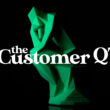Sara Richter is Emarsys‘ CMO and, as such, has a lot to say about how to – and how not to go about omnichannel personalization initiatives at scale. With clients such as Gibson Guitars, Puma, Pizza Hut and a slew of other top brands, Emarsys is in a good position to opine and advise on the topic.
Want to know how the big brands are pulling it off? Give a listen – I don’t think you’ll be disappointed.
Also -special thanks to Verint for their sponsorship of this episode.
Mike Giambattista (00:01):
If I have this right, the great retail race. New research reveals expanding disconnect between customer and retailer perceptions. And I’m just gonna editorialize a moment and say, that’s being really kind.
Sara Richter (00:51):
<Laugh>. We try, I mean, we, we do love retailers. They are, they are our customers, right? And they are, they, I mean, what they’re trying to do, and we talked about this, it’s not easy what they’re trying to do, actually. It is actually really hard. And I think, I think when we all talk about it, we do have a tendency because we talk about it a lot. In fact, I think that’s something you and I touched on as we were sipping coffee in a, a godly hour that was early at N R F, right? <Laugh>, it isn’t, it is hard to do this, right? And it’s hard to do this at scale, and it’s hard to do this across different channels, and it’s hard to do it across different countries and cultures and products. And there is an awful lot of complexity that faces a retailer.
And then, then this year, you know, you’re adding the pressures of the economy in a whole different way. And, you know, people are price conscious in a way they haven’t been in a while, and they really haven’t. There’s been, there was this nice, there was this nice boom from post covid, a lot of retailers who thought Covid was gonna be such a disaster for them, did these incredibly creative things, and they flipped into digital commerce in ways that they probably couldn’t have even imagined a couple of ago. Right. And reaped the benefits both in terms of their revenue, their customer loyalty, the relationships with their customers, and then the whole world changed again this year,
Mike Giambattista (02:07):
<Laugh>, right, right. Just when you thought it was safe to go back in the water.
Sara Richter (02:12):
Exactly. And, and you know, there, there, there, there. It’s not. So I do think, I do think they’re struggling. I think they’re struggling with so many different things. And the, that balance of, we’ve returned back to that balance of in-store again. And what is, how do you do that? How do you balance that? How do you acknowledge me as a, as the same customer who bought on the app and your website and also went in store to try on that dress? And how do you connect that in a way that actually makes me feel that I’ve had a, a real experience, a personalized experience. That’s hard.
Mike Giambattista (02:46):
It’s, it’s really difficult. And, and I think, you know, with your platform and a few others that are out there on the market, it finally became possible to, to make a genuine omnichannel connection and engage people all these channels. And that’s only been a fairly recent development. It’s always been kind of the brass ring and the ultimate goal of all these things. But, you know, it wasn’t until, I don’t know, just a couple of years ago, really, when you could, you could assemble all these pieces to create multiple touchpoints. And then I think people like Marsha started figuring out, wait a second, we could assemble all this into one platform. And decomplexify, I just made that word up. Why tech stacks for marketers and make the whole thing a lot easier. But I mean it, so the disconnect between what, what customers think and what retailers think they’re thinking, I think has always been there.
I mean, it, it’s, it’s and you could pick whatever realm you want and you could go spend what amounted to a small fortune on consumer research to try and figure out what your customers were thinking, feeling about one realm. But then that, that kind of, that’s good for a moment in time. But it seems like what a Maras is doing is you could drive realtime data right back to the brand and say, this is what’s happening here and now it’s really a byproduct of all of your marketing activities. So it’s not necessarily, again, I’m making this up, but I’m assuming it’s not a separate extra spend for those insights. It’s basically the exhaust that comes out of all the marketing activities.
Sara Richter (04:29):
It’s all about putting your data to use, isn’t it? And giving you, we allow you to get the most outta that data. And I think what marketers, and whether they’re in retail or not, or challenge with, I know my team talks about this data, lack of data is not a problem any of us face. We haven’t faced that in many moons, and I don’t think we ever will. But what we do face is the challenge of actually making that data work for us and really getting those insights and having them be consumable and then actually actionable. So can and, and not actionable in three weeks <laugh> when the moment has passed
Mike Giambattista (05:02):
<Laugh>, right? Or worse in some cases.
Sara Richter (05:04):
Yeah, exactly. Or, yeah. So truly actionable. And are you, so does that allow you as a marketer or as a retail marketer, to talk to me as a consumer about the right thing at the right time? The way the tone, the content is just as important the way I wanna be spoken to on the channel. I want you to talk to me about, so are you there when I want you to be there? Are you on mobile when I want you to be on mobile? Are you online when I want you to be online? Are you in store with all that information when I want you to be in store,
Mike Giambattista (05:37):
Which is all moment sensitive, you, I mean, absolutely. You can’t make those assumptions that omnichannel is everywhere all the time because I mean, you, you tend to take a couple of steps back from genuine personalization if you approach it that way.
Sara Richter (05:51):
And that’s, and that’s what our, that that’s what we, one of the things we would say as some of our secret sauce is we pers we, we don’t, we don’t say, Hey, we’re gonna personalize to you, Mike, on the mobile app, and then think about in a, in a complete silo how we’re gonna personalize to you on a website and then to you in a store. We think about it holistically. We think about Mike as the consumer and how are we, and we will talk to you across all those channels and we’ll assume that’s the, that’s what’s going to happen. So our personalization is agnostic in that respect. It goes across all those channels and then it, and it moves hopefully with you as you move. And I think that’s where the, that’s the secret for retailers at the moment because it’s personalization, which impacts the tone and the content and the product and the number of times that you interact, right? We have research that talks about how, you know, most marketers think that consumers wanna hear them carefully like three times a week, and they don’t.
A Word from Our Sponsor
I want to take a quick break from my conversation with Sara to acknowledge and thank our sponsors. Today’s episode is brought to you by our good friends at Verint, the customer engagement company. Verint helps some of the world’s most iconic brands build and during customer relationships by connecting work data and experiences across the enterprise. What’s more, Verint shares the same customer obsession we have here at customer land. Over the past three years, Verint has conducted research that identified a chasm that exists between what organizations know they need to do to meet rising customer expectations and the resources they have to actually do it. It’s called the engagement capacity gap to help bridge that gap. Verint empowers businesses to effectively listen to customers, analyze both strategic and individual level data act to engage customers and deliver differentiated experiences at scale. Recently recognized by industry analysts for their innovation and platform capabilities, verin offers proven solutions that organizations need to deliver exceptional and unique customer experiences ready to close the engagement capacity gap at your business. You can learn more at Verint.com. That’s V E R I N T.com.
Mike Giambattista (08:09):
I’m looking for the data here because this was wild. Here we go. When it comes to when it comes to frequency of engagement, a whopping 61% of retailer survey believe their customers want to hear from them multiple times a week. In reality, only 31% of consumers agree with the majority preferring to be contacted once a week or less, if at all.
Sara Richter (08:29):
Yeah. That, that,
Mike Giambattista (08:32):
I mean, so is it, so I’m a marketer. I’ve worked for some fairly large brands. You do this all day long. There’s a, I’m trying to say this without sounding pejorative about my marketing colleagues, but you know, there, it seems like if you don’t have the technology to to reach people in the moment where they are when they want to be spoken to and how they want to addressed, then it’s a lot easier to, to just basically apologize afterward. And, and that seems to be what a lot of marketers are opting for because, you know, achieving that kind of personalization is, is, as you said, difficult
Sara Richter (09:16):
Is difficult, but it’s also not insurmountable. And I think it’s, so it comes back to some other research actually that we did. And actually I think you and I spoke about N R F as well that we did with Forester. And it’s all around customer obsession, and which I love, I love that phrase customer obsession. And it talks about the differences between all companies will say they, they’re looking to, they have a great customer experience, right? They think about cx. There’s a difference between CX and customer obsession. And customer obsession is really about taking the customer and making it the center of your business in all aspects. Not just the commerce or the marketing, the strategy, the way you’re thinking your operations, everything you do centers around the customer. This customer becomes a center of gravity. And a surprisingly few number of organizations, when you go through the que a questionnaire and talked about what they’re doing, actually genuinely qualify as that. But what’s really interesting is the ones that do are also interestingly far more likely to have a successful omnichannel strategy.
Mike Giambattista (10:19):
Imagine my surprise,
Sara Richter (10:21):
They, they’ve made the connect. They have, they have absolutely committed to that fundamental connection of how do we need to a really obsess about our customers. And they’re, they’re, they’re making that part of what they do. And then it cr it makes that other, if you like, if you, if we wanna create a triangle with, you know, obsession and, and personalization, you get loyalty because that’s what drives loyalty. You are communicating with people the way they want to be communicated with when they want to be communicated with how they want to be communicated at the frequency they want to be communicated with. And that’s what drives real brand loyalty. And the index that you were talking about that we came out with, talked about the different kinds of loyalty in there. And I, I I, we ha you, I’m sure we can, we can put up a slide or something if you want to, that shows it.
But what was really interesting to me was that in a year where there’s so much economic pressure on consumers, you would think that where consumers are going not unreasonably would be where the, wherever the deals were. And that, that’s the kind of loyalty that would be the loyalty that is, is on the rise. And it wasn’t, it was real true brand loyalty that was on the, on the rise, which said that that was, that was one upping that need for necessarily the cheapest price for the cheapest item. Now, I’m sure people are also looking at that. I don’t wanna suggest they’re not, that would be foolish. Sure.
Mike Giambattista (11:43):
But that, that tends to be more of a category by category thing. But in certain categories, if you’re, if you’re loyal to a brand we’ve seen data that proves that there’s gonna have to be a pretty big shift in value change in the, the perceived values in order for a customer to leave that loyal brand that they love because they’ve, they’ve somehow, they’ve rewired their relationship to that brand to go well beyond what it costs them and dollars and cents.
Sara Richter (12:09):
Exactly.
Mike Giambattista (12:10):
So we may have mentioned this, I can’t even remember, but you brought up an interesting topic, that there are very few companies who have, who have figured out that they want to and need to genuinely put the customer at the center of their business. And you know, we have kind of an inside snicker here the customer, when we see companies describe themselves as customer centric, it’s like, of course you do. You have to say that. But, but what does that really look like in reality? And so we did a study, this is about a year and a half ago, almost two years ago now, just to see what this would dredge up here. And we looked at the Fortune 50, and we went through all their 10 Qs and 10 Ks, and we were looking for mentions of customer centricity or cx or chief customer officer, or any of those kinds of keywords or ideas that would indicate that customer centricity is something more than just a buzzword of the moment that they’re really doing something about it.
And no, it’s not very scientific and there’s a lot of play in there, but it was remarkable. It came out to somewhere around 10% of the companies in the Fortune 50 that actually looked like they were doing something about it. And you had to be pretty subjective about, about looking through that. But that’s a really small number for something that I think as marketers, we kind of get intuitively this is just how it has to be. So my question is, there was a question at the end of all that is how do you find those people? How do you identify ’em? How do you, is it, is it something that a Mars’ kind of grows and shapes these people into companies like that? Or do you look for them specifically?
Sara Richter (13:55):
I think there’s probably a little bit of both. I mean, realistically, I think companies that are thinking about, you know, these things as imperatives that are thinking about how they communicate, are thinking about the customer communication, that engagement constantly that are, that for per them personalization for example, is an imperative. Loyalty is an imperative. They’re gonna naturally be talking to somebody like us because they’re gonna understand that we are an important piece of the puzzle. But also fair to say, we’re only a piece of that puzzle, right? And there’s a bigger, and it’s not just having the marketer or your chief digital officer or your head of commerce bought into it. When I say that real customer obsession, it’s, it’s that strategy, right? It’s that you’re, it’s, it’s that your CEO and your board are, are bought into this, and your company is genuinely thinking about this as a center of gravity.
And that’s where, that is what you rotate around. And when you look at your KPIs, they’re not, they’re not excuses, they’re not, they’re actually about the customer. They’re not things that are actually really about you as a company. And when you start to see that, then you start to see the impact. I think it also doesn’t hurt that when you companies invest in some, in a platform, like in a Marist, they hopefully start to see the results, right? They’re starting to think in a different way, act in a different way, engage in a different way with their, with their consumers. And they see the benefits of that. And it’s hard to see, right? That that strategy isn’t just altruistic, it does actually impact the bottom line. And hopefully they are becoming a center of gravity within their, within whatever products or world they’re in. And their competitors may well see that they’re starting to lose consumers lose that person who puts the product into Google shopping and clicks on the whatever vendor is offering it for the least price, regardless of what vendor that is, versus the person that has, you know, that has the, the store app on their phone that just automatically when they want to buy X goes back and reorders it and picks up something else at the same time.
Mike Giambattista (15:54):
So, so if you’re listening to this, you, you probably get by now that Sarah and I could talk about this stuff passionately for hours and hours and hours and, and we’re well on our way to doing that. But for the sake of people listening and, and your schedules so one other data point in your report according to the research, the vast majority, 82% of retailers surveyed always review customer feedback in full and make adjustments accordingly. And I thought that was a pretty big number because I fit squarely into the other group that says, however, only 30% of customers think that retailers really review the feedback provided with 16% believing, although their feedback is read, no real changes are made. So, I mean, I don’t know that the am marcis platform, because as sophisticated as it is, can address that consumer perception that retailers don’t really care. They care about my dollar and my transaction and, but they’re not really gonna listen to my either comments or criticisms. And yet, I mean, I’m, I’ll bear witness. Every company that I’ve worked with in that realm pays really, really strong attention to consumer feedback, especially the negative ones. It’s not to say that it, it, it automates a change. You know, you’re not gonna necessarily mean a put a course correct in effect because of one or two comments, but, but companies generally want to hear this stuff.
Sara Richter (17:25):
I think they do. And I think most companies, they do care and they, they do, they’re listening a lot more than consumers necessarily realize. But I think the actions always speak louder than words, right? That that is, that is true across, across the border in our lives and in many other realms. But I think also much of what consumers are talking about often is an, an isolated incident, right? They’re talking about the approach to them as a customer and they’re talking about the exp overall experience. They may have chosen to leave a review about x, Y, Z product or x y, Z interaction, or there’s a bad delivery experience or whatever the thing is. And maybe they’ve even left several. But what they tend to, I think, be reacting to is the bigger thing. Do they feel valued? Do they feel valued by that company, that brand?
Do they feel that their business makes them by more than just, I spent 9 99 on Hairspray, right? Right. More, it’s more than that. Do you value me? So when I interact with you, however I’m interacting with you, whenever I’m interacting with you, is, is there that sense of engagement? Is it per, is it a personalized engagement? Does it happen at the right? All those things we spoke about a few minutes ago, does it happen at the right Cadence is the content things that I wanna consume, you know, that’s don’t bombard me with offers for products that you should know I’m not interested in, or, you know, don’t bombard me with an offer on Wednesday for a 500 milliliter can of hairspray when, you know, I bought one at, you know, nine o’clock o’clock last night, <laugh> <laugh>.
Mike Giambattista (19:07):
I hate when that happens. <Laugh>,
Sara Richter (19:09):
I, I’d like appreciate that. I know how you’re by your hairspray <laugh>,
Mike Giambattista (19:12):
Right? Yeah, I know. No comments. That’s why we’re doing this as a podcast.
Sara Richter (19:17):
Exactly. Exactly.
Mike Giambattista (19:19):
No, but, but I think there’s probably a strong case to be made too, that if there’s one customer who felt strongly enough about the situation to comment that there’s probably a whole iceberg underneath that one customer of dissatisfaction. And, you know, and that, that I think is why a lot of these companies don’t look at the one complaint as one isolated incident. Because there’s probably more to it than that. The other thing that occurred to me just as we were just chit-chatting here is that the resistance that I’ve seen that, that companies would, would see this and, and kind of look away from it. There are two phenomena I’ve seen, I’d be interested in yours. One is they just can’t get to it. Cause everybody’s running hard and fast and oh man, that slipped through the cracks and I’ll fix it, but I gotta run over here real quick. That’s one phenomena. And the other is that I’ve only seen this a couple times, but I have seen it, is that in middle management, somebody’s charged with reviewing and collecting these kinds of comments. And if you are bonus or whatever it happens to be is measured on CSAT scores or nps, and you’ve gotta deliver something that’s gonna go contrary to that. There’s a little bit of resistance to be like, oh wait, you know, oh, dog on it. I can’t get to that right now. I will focus on this other stuff.
Sara Richter (20:49):
So yes, actually I’ll tie that back to what we were talking about earlier. Sorry, be boring. That’s, that’s, that means that company isn’t truly customer obsessed because the KPIs are not motivating people to think about that customer or that group of customers in a way that’s actually productive both for the customer and the company. It’s a clash. Yeah. Which means that they’re not, they may be worrying about the customer experience, which I’m sure they are. Cause I think most companies do, and I, I truly believe most companies do, but it’s not the center of gravity. It has KPIs that send people off into other directions that don’t fix problems with the customer. Yep, yep. And don’t give that, don’t give them that sense. Don’t give them that sense that they are that important, that they are that valued. They’re not acting on it and thinking about it that way. They’re worrying about exactly what you’ve said. And it’s, it’s an opportunity to look at those KPIs around the customer and say, are they the right ones? They may be the traditional ones, maybe the ones we’ve used for however many years, but is that really driving the right behavior and allowing us to take that customer relation, those customer relationships to the next level? I think that’s a valid question to ask.













